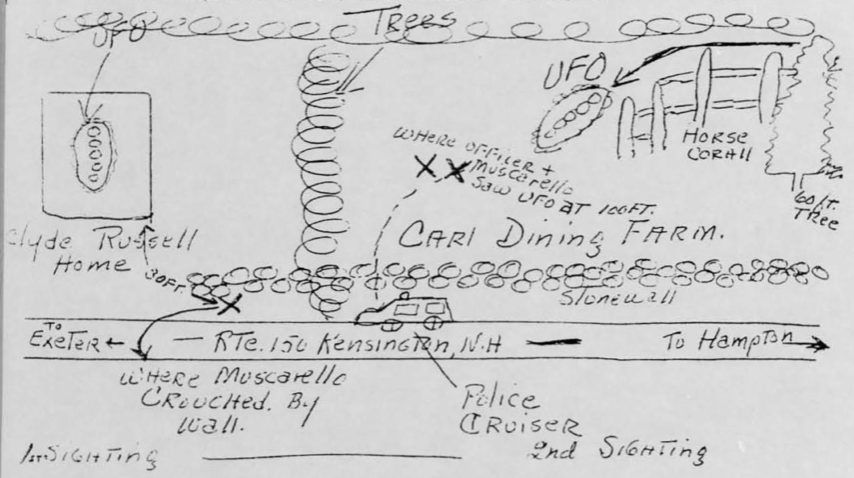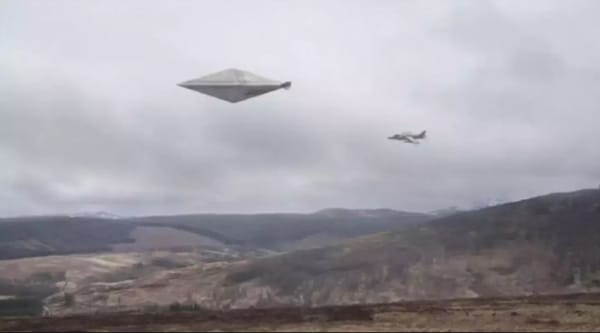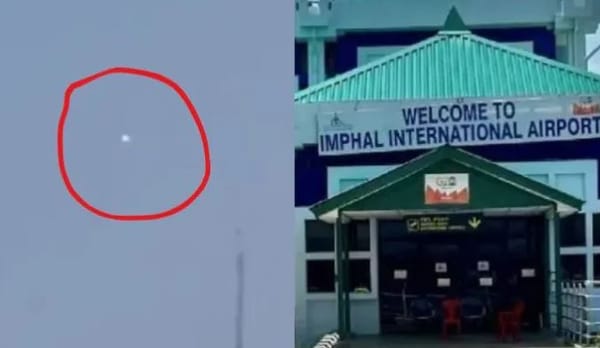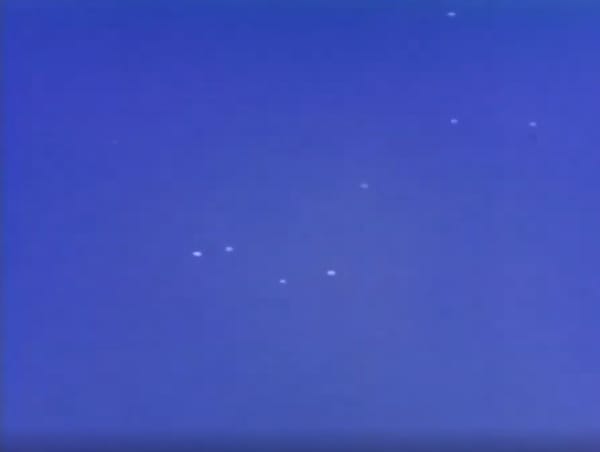The 1966 Exeter UFO Incident

The Exeter Incident, often referred to as the Incident at Exeter, is one of the most widely publicized and thoroughly documented UFO sightings in American history. Occurring on September 3, 1965, near the town of Exeter, New Hampshire, this event captivated public and media attention due to the credibility of its witnesses and the mysterious nature of the encounter. The incident involved an 18-year-old local resident, Norman Muscarello, and two Exeter police officers, Eugene Bertrand and David Hunt, who independently reported witnessing an unidentified flying object displaying unusual behavior and emitting bright red lights.
Muscarello's frightening experience, combined with the corroborative accounts of the police officers, sparked extensive media coverage and led to an official investigation by the United States Air Force's Project Blue Book. Despite various explanations proposed over the years, including those by military and skeptical investigators, the incident remains unresolved. The Exeter Incident has since become a significant case in the annals of UFO lore, symbolizing the enduring mystery and public fascination with unidentified aerial phenomena.
The Incident
In the early hours of September 3, 1965, 18-year-old Norman Muscarello was hitchhiking along Route 150 near Kensington, New Hampshire, a few miles south of Exeter. Muscarello, who had recently graduated from high school and was soon to enlist in the U.S. Navy, had spent the evening visiting his girlfriend in Amesbury, Massachusetts. As he made his way back home, he encountered little traffic and ended up walking much of the distance.
At approximately 2:00 a.m., Muscarello observed five bright red lights in the sky, which he initially assumed were from a police car or fire engine. However, as he got closer, he realized the lights were hovering above the trees, illuminating the nearby fields and houses with a vivid red glow. The lights appeared to be part of a large, silent, oval-shaped object, estimated to be around 80 to 90 feet in diameter. Startled and frightened by the sight, Muscarello sought refuge in a ditch by the road.
The object then shifted its position, moving toward a nearby farmhouse owned by the Dining family, who were not home at the time. Muscarello ran to another house belonging to the Russell family, frantically pounding on the door for help, but received no response. He later learned the Russells were too scared to open the door despite hearing his pleas. The UFO soon moved away, disappearing over the trees.
Seeing the headlights of an approaching car, Muscarello flagged it down. The occupants, a couple, drove him to the Exeter police station, where he arrived pale and visibly shaken. At the station, he recounted his experience to Officer Reginald Toland, who, impressed by Muscarello’s distress, radioed Officer Eugene Bertrand Jr. for assistance.
Earlier that evening, Bertrand had encountered a woman on Route 108 who reported being followed by a "huge object with flashing red lights" from Epping to Exeter. Initially skeptical and dismissing the woman’s claims, Bertrand was now faced with a similar story from Muscarello. Intrigued, Bertrand decided to investigate further and drove Muscarello back to the site of the sighting.
Upon arrival, Bertrand and Muscarello initially saw nothing unusual. However, as they walked into the field, the nearby horses became agitated, and the dogs started barking. Suddenly, a large, dark object with red flashing lights emerged from behind the trees. Bertrand described it as "a huge, dark object as big as a barn," which moved silently and swayed back and forth. Instinctively, Bertrand dropped to one knee, drew his revolver, and pointed it at the object, but decided against firing. He and Muscarello retreated to the patrol car.
Bertrand radioed for backup, and Officer David Hunt soon arrived. While waiting, the two officers and Muscarello continued to observe the object, which hovered about 100 feet away at an altitude of 100 feet. The red lights flashed in a rapid sequence, causing the local animals to remain agitated. The object eventually ascended over the trees and disappeared from sight just as Hunt arrived, who also witnessed the tail end of the sighting.
The three men returned to the Exeter police station, where they separately documented their observations. Bertrand then drove Muscarello home, informing his mother about the night's unusual events. Despite various investigations and explanations offered later, the Exeter Incident remains one of the most compelling UFO sightings due to the credibility of the witnesses and the detailed accounts they provided.
Aftermath
The Exeter Incident quickly gained national attention, sparking widespread interest and debate. Following the sighting, the Exeter police chief contacted Pease Air Force Base to report the UFO encounter. In response, Major David Griffin and Lieutenant Alan Brandt from the Air Force were dispatched to interview Norman Muscarello and the two officers, Eugene Bertrand and David Hunt. The Air Force personnel found the witnesses credible and reliable, noting the lack of any immediate explanation for the sighting.
Despite this, the initial Air Force explanation given to the public was dismissive. They attributed the sightings to stars and planets twinkling due to a temperature inversion. This explanation was met with skepticism and ridicule from the witnesses and the broader community. Muscarello, Bertrand, and Hunt, all strongly disagreed with this assessment, insisting that what they saw was a solid, structured object, not a natural phenomenon or conventional aircraft.
To further investigate the incident, renowned journalist and UFO researcher John G. Fuller traveled to Exeter. Fuller, known for his thorough investigative work, interviewed numerous residents who had reported similar sightings in the area. He documented these accounts in his book, "Incident at Exeter," which became a bestseller and brought even more attention to the case. Fuller’s work highlighted the consistency and credibility of the eyewitness reports, further challenging the Air Force’s explanation.
As the controversy grew, the National Investigations Committee On Aerial Phenomena (NICAP), a civilian UFO research group, also conducted an investigation. Raymond Fowler, NICAP’s New England investigator, compiled a detailed report that supported the witnesses' claims and criticized the Air Force’s handling of the case. Fowler and others pointed out inconsistencies in the official explanations and emphasized the need for a more thorough and unbiased investigation.
The Air Force’s initial explanation was eventually revised. In a letter to the policemen, Lieutenant Colonel John Spaulding from the Office of the Secretary of the Air Force acknowledged that they had been unable to identify the object observed on September 3, 1965. This admission did little to quell the controversy, as many felt it came too late and did not address the core issues raised by the witnesses and investigators.
Despite the ongoing debate, the Exeter Incident remained one of the most well-documented and compelling UFO cases. It inspired further research and public interest in UFO phenomena. Norman Muscarello, who went on to serve in the Navy, continued to assert the authenticity of his experience until his death in 2003. Officers Bertrand and Hunt also stood by their accounts, reinforcing the incident’s credibility.
In the years following the incident, the Exeter community embraced its place in UFO history. In 2010, the Exeter Kiwanis Club established the "Exeter UFO Festival" as a fundraising event for local children’s charities. The festival celebrates the town's unique connection to UFO lore and attracts enthusiasts and researchers from around the world.
The Exeter Incident remains a significant case in the study of UFOs, illustrating the complexity and controversy that often surround such encounters. The credible witnesses, detailed reports, and subsequent investigations ensure that the events of that early September morning in 1965 continue to intrigue and provoke discussion among UFO researchers and the general public alike.
Possible Explanations
The Exeter Incident has generated numerous theories and hypotheses over the years. While some explanations are grounded in conventional science and skepticism, others entertain the possibility of extraterrestrial involvement. Here are some of the most discussed explanations:
1. Astronomical Phenomena
The initial explanation provided by the Air Force attributed the sightings to stars and planets twinkling due to a temperature inversion. This phenomenon can cause light from celestial bodies to refract in the atmosphere, creating unusual visual effects. However, this explanation was widely criticized by witnesses and researchers who argued that the behavior and characteristics of the object observed did not match those of astronomical phenomena.
2. Military Aircraft
Another explanation suggested that the witnesses might have seen military aircraft from the nearby Pease Air Force Base. A specific hypothesis proposed by skeptics Joe Nickell and James McGaha in 2011 involved KC-97 tanker aircraft. These tankers, used for aerial refueling, had a pattern of flashing red lights and a refueling boom that could resemble the described UFO when seen under certain conditions. However, witnesses, including the police officers, reported distinct differences between the UFO and conventional aircraft, particularly noting the UFO's silence and unusual maneuverability.
3. Weather Balloons or Atmospheric Probes
Weather balloons and other atmospheric research devices have often been mistaken for UFOs. These balloons can reflect light in ways that might confuse observers, especially at night. Yet, the size, behavior, and duration of the sightings in Exeter do not align well with typical characteristics of weather balloons, making this explanation less likely.
4. Extraterrestrial Craft
The possibility that the Exeter UFO was an extraterrestrial craft remains a popular and intriguing theory. Proponents argue that the detailed descriptions of the object's size, shape, and behavior—combined with the high credibility of the witnesses—suggest something beyond conventional human technology. The object’s ability to hover silently, its rapid and precise movements, and its effect on local animals all contribute to the plausibility of an extraterrestrial origin.
5. Psychological and Sociological Factors
Some researchers suggest that the sightings could be the result of psychological or sociological factors, such as mass hysteria or collective misperception. This theory posits that the initial sighting by Muscarello, coupled with the media attention and subsequent investigations, might have influenced others to interpret ordinary objects or lights as UFOs. However, this does not adequately explain the consistency and detail of the independent reports from multiple witnesses, including trained police officers.
6. Experimental Technology
Another speculative theory involves the possibility of secret experimental technology being tested in the area. This could include advanced aircraft or surveillance drones not publicly known at the time. While plausible, there is no concrete evidence to support this theory, and it remains speculative.
Conclusion
The Exeter Incident remains one of the most compelling and well-documented UFO cases in history. While many conventional explanations have been proposed, none have conclusively accounted for all the details observed by the witnesses. The possibility of an extraterrestrial craft, while controversial, continues to be a significant part of the discussion. As with many UFO cases, the lack of definitive evidence leaves room for ongoing debate and speculation. The Exeter Incident stands as a fascinating example of the complexities and mysteries that surround UFO sightings, challenging our understanding of the skies above.



